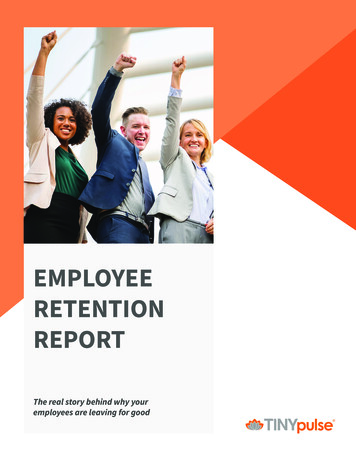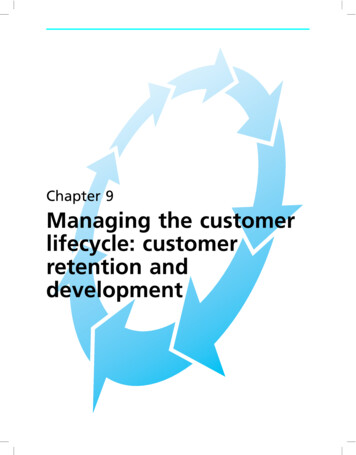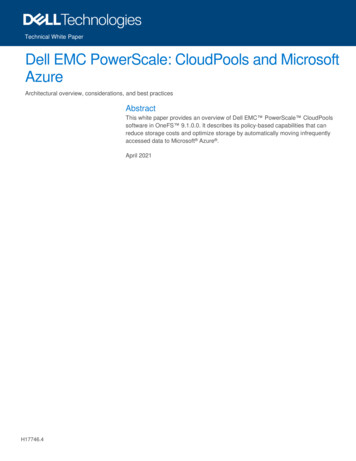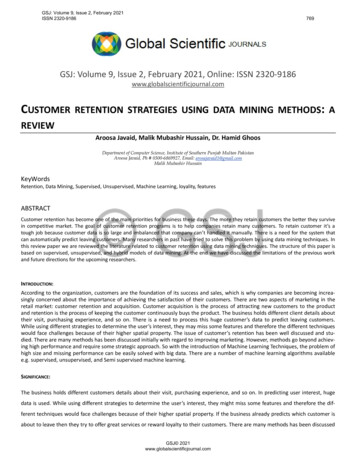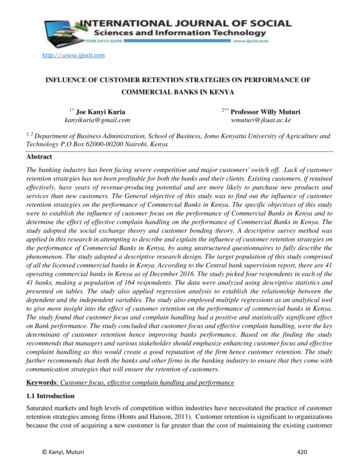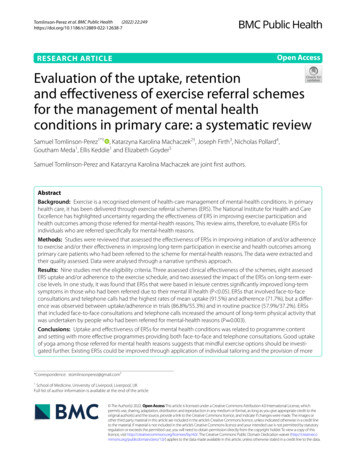
Transcription
(2022) 22:249Tomlinson‑Perez et al. BMC Public SEARCH ARTICLEOpen AccessEvaluation of the uptake, retentionand effectiveness of exercise referral schemesfor the management of mental healthconditions in primary care: a systematic reviewSamuel Tomlinson‑Perez1*† , Katarzyna Karolina Machaczek2†, Joseph Firth3, Nicholas Pollard4,Goutham Meda1, Ellis Keddie1 and Elizabeth Goyder5Samuel Tomlinson-Perez and Katarzyna Karolina Machaczek are joint first authors.AbstractBackground: Exercise is a recognised element of health-care management of mental-health conditions. In primaryhealth care, it has been delivered through exercise referral schemes (ERS). The National Institute for Health and CareExcellence has highlighted uncertainty regarding the effectiveness of ERS in improving exercise participation andhealth outcomes among those referred for mental-health reasons. This review aims, therefore, to evaluate ERSs forindividuals who are referred specifically for mental-health reasons.Methods: Studies were reviewed that assessed the effectiveness of ERSs in improving initiation of and/or adherenceto exercise and/or their effectiveness in improving long-term participation in exercise and health outcomes amongprimary care patients who had been referred to the scheme for mental-health reasons. The data were extracted andtheir quality assessed. Data were analysed through a narrative synthesis approach.Results: Nine studies met the eligibility criteria. Three assessed clinical effectiveness of the schemes, eight assessedERS uptake and/or adherence to the exercise schedule, and two assessed the impact of the ERSs on long-term exer‑cise levels. In one study, it was found that ERSs that were based in leisure centres significantly improved long-termsymptoms in those who had been referred due to their mental ill health (P 0.05). ERSs that involved face-to-faceconsultations and telephone calls had the highest rates of mean uptake (91.5%) and adherence (71.7%), but a differ‑ence was observed between uptake/adherence in trials (86.8%/55.3%) and in routine practice (57.9%/37.2%). ERSsthat included face-to-face consultations and telephone calls increased the amount of long-term physical activity thatwas undertaken by people who had been referred for mental-health reasons (P 0.003).Conclusions: Uptake and effectiveness of ERSs for mental health conditions was related to programme contentand setting with more effective programmes providing both face-to-face and telephone consultations. Good uptakeof yoga among those referred for mental health reasons suggests that mindful exercise options should be investi‑gated further. Existing ERSs could be improved through application of individual tailoring and the provision of more*Correspondence: stomlinsonperez@gmail.com†1School of Medicine, University of Liverpool, Liverpool, UKFull list of author information is available at the end of the article The Author(s) 2022. Open Access This article is licensed under a Creative Commons Attribution 4.0 International License, whichpermits use, sharing, adaptation, distribution and reproduction in any medium or format, as long as you give appropriate credit to theoriginal author(s) and the source, provide a link to the Creative Commons licence, and indicate if changes were made. The images orother third party material in this article are included in the article’s Creative Commons licence, unless indicated otherwise in a credit lineto the material. If material is not included in the article’s Creative Commons licence and your intended use is not permitted by statutoryregulation or exceeds the permitted use, you will need to obtain permission directly from the copyright holder. To view a copy of thislicence, visit http:// creat iveco mmons. org/ licen ses/ by/4. 0/. The Creative Commons Public Domain Dedication waiver (http:// creat iveco mmons. org/ publi cdoma in/ zero/1. 0/) applies to the data made available in this article, unless otherwise stated in a credit line to the data.
Tomlinson‑Perez et al. BMC Public Health(2022) 22:249Page 2 of 17face-to-face consultations, and social support. Further research is required to identify the types of ERSs that are mostclinically effective for those with mental ill health.Keywords: Mental health, Anxiety, Depression, Physical activity, Exercise referral schemes, Uptake, Adherence,EffectivenessBackgroundUp to 15% of the UK population may experience a mental-health disorder at any one time [1]. Depression andanxiety are two of the commonest conditions. Depression is a leading cause of disability globally and is theleading cause worldwide of disability and prematuredeaths in adults aged 18-44 [2]. It has a prevalence of4.5% among UK adults and is characterised by constantlow mood and/or the loss of enjoyment in the majorityof their activities (i.e. anhedonia), and a range of relatedemotional, cognitive, physical and behavioural symptoms [2]. Approximately 25% of adults experience anxiety at some point in their lives [3]. Generalised anxietydisorder is characterised by disproportionate, pervasive, uncontrollable and widespread levels of worry,with potential somatic, cognitive and behaviouralsymptoms [3]. Anxiety and depression form one of themost common comorbidities [4]. Approximately 67% ofthose with depression are thought to have a comorbidanxiety. Similarly, 63% of those with a primary anxiety disorder are likely to have concurrent depression[4]. Findings from a recent UK survey suggest that theincidence of stress has increased, with 74% of adultsreporting that they feel overwhelmed or unable to copedue to mental or emotional pressures [5]. Individualsmay also have multiple mental health conditions at anygiven time.Primary care plays a central role in the managementof mental ill-health; up to 90% of depression and anxietycases are managed in this setting [1]. Numerous management methods are available in primary care for mentalhealth conditions, including lifestyle advice, medicationand psychotherapy. Increasing physical activity levels is acommon lifestyle recommendation for many health conditions, as it has been demonstrated to improve overallhealth outcomes, quality of life, functional capacity andmood [6]. Physical activity is defined as any skeletal bodymovement that requires energy expenditure. Exercise is asubset of physical activity that is planned, structured andrepetitive, with the goal of maintaining or improving fitness levels [7]. More specifically for mental health, physical activity has been shown to be effective for stress [8],clinical depression and anxiety [9]. Meanwhile, individuals not participating in regular physical activity are twiceas likely to display depression and anxiety symptoms [10].Furthermore, physical inactivity contributes towards thehigh levels of cardiometabolic diseases observed in people with mental illness [11].Despite the well-known health benefits of exercise [12],many people lead sedentary lives, this is particularly thecase for those with mental ill health [13]. In England, forexample, 34% of men and 42% of women do not achievethe recommended amount of weekly aerobic exercise(150 min of moderate activity or 75 min of vigorousactivity) [14]. Additionally, 27% of adults exercise for lessthan 30 min a week and are thereby classified as inactive[15].One way to increase activity levels among sedentaryindividuals is through exercise referral schemes (ERS).These consist of an assessment by primary care or alliedhealth professionals, followed by referral to a physicalactivity specialist and/or service. The patient is advisedon the type of physical activity that suits the specificneeds of the individual and he or she is given the opportunity to take part in an exercise programme [16], oftenbased in a leisure centre [17]. ERSs can be funded bycommissioners for the rehabilitation and managementof certain health conditions including myocardial infarctions, stroke, chronic heart failure, chronic obstructive pulmonary disease, lower back pain and depression[16]. Individuals with stress and anxiety are also eligiblefor the scheme [18]. There are currently no standardisedprotocols for how ERS programmes are delivered or thetype of exercises that are involved. This means a varietyof ERSs are offered in the UK and there are currently noset guidelines for the type of ERSs that should be usedin patients referred for mental health reasons. A lack ofevidence regarding effectiveness for specific schemes orpopulation subgroups is the primary cause for this [16]. Itis, however, important to stress that a lack of standardisation in ERSs for mental health referrals is not necessarilynegative, with increased individualisation of exercise programmes shown to improve engagement in this clinicalpopulation [19].A preliminary literature search highlighted a gap inevidence regarding the effectiveness of ERSs on mentalhealth, and this is supported by the latest National Institute for Health and Care Excellence (NICE) guidance onERSs [16]. Previous reviews have assessed mental healthoutcomes in ERSs as part of a wider review scope [20,21], but none have focused on mental health specifically.Additionally, many of the studies included participants
Tomlinson‑Perez et al. BMC Public Health(2022) 22:249referred for non-mental health reasons in the assessmentof mental health outcomes. To reliably evaluate ERSs as amanagement method for patients with mental illness, it isimportant to analyse the body of research which focuseson participants with mental health diagnoses as theirprimary reason for referral. The emphasis was placed onstudies focusing on depression and anxiety since theyare the most prevalent mental health disorders in theUK population [2, 3]. Other mental health conditions,such as stress or post-traumatic stress disorder were alsoincluded in the review.This review also explored the suitability of ERSs as anintervention in the real world by examining uptake andadherence. Both at the individual and population level,uptake and adherence are an important aspect of abilityto benefit from an intervention. Assessing whether ERSsinfluence long-term physical activity levels is anotherimportant measure of effectiveness in those referredfor mental health reasons. No reviews were found thatexplored all of these areas.The aim of this review was to evaluate the use of ERSsas a management method for individuals referred formental health reasons in a primary care setting. Toaddress this aim the following primary objectives wereset:1. To assess the clinical effectiveness of ERSs on mentalhealth symptoms in participants referred for mentalhealth reasons.2. To assess levels of uptake and adherence to ERSsamong participants referred for mental health reasons.3. To assess the effects of ERSs on long-term physical activity levels in participants referred for mentalhealth reasons.Page 3 of 17The secondary aim of this review was to assess uptakeof and adherence to exercise programmes in mentalhealth referrals compared to non-mental health referralsin included studies.MethodsSearch strategy and study selectionAdhering to PRISMA guidelines [22], a literature searchwas conducted in five electronic databases: MEDLINE,PsycInfo, CINAHL, Scopus, and the Cochrane Library.A pre-specified review protocol was created for ERSs inmental health conditions (Additional File 1). The reviewwas restricted to publications written in the English language, due to a lack of translation resources. Databaseswere searched from inception to July 2020. The searchterms included ‘exercise’, ‘physical activity’, ‘referral’, ‘mental health’, ‘depression’, ‘mood disorders’, ‘affective disorders’, ‘anxiety’, and ‘anxiety disorders’. Detailed searchstrategies for all databases are presented in Table S1(please see Additional file 2). Reference lists of relevantstudies were scanned, and citation searches using GoogleScholar were also undertaken. Deduplication was performed for all records identified. Titles and abstracts ofremaining records were screened to exclude irrelevantstudies. All remaining articles were read in full andselected for inclusion if they met the eligibility criteria.All titles and abstracts were reviewed by two independent reviewers (STP & GM) to determine appropriatenessto the purpose of the review. Any disagreements overstudy inclusion were resolved by discussion. Similarly,the two reviewers reviewed full texts independently andcompared these against predefined eligibility criteria toconfirm the article’s appropriateness for inclusion in thereview.Table 1 Inclusion criteria based on PICO frameworkInclusion Criteria1. Study participants were diagnosed with a mental health condition, with primary care being the main source of referral.2. Mental health was the primary reason for referral.3. Studies evaluating ERS, as defined by Pavey et al. [21]o Referral by a primary-care health-care professional to a service designed to increase physical activity or exerciseo Physical activity/exercise programme tailored to individual needso Initial assessment and monitoring throughout the programme4. Studies with any relevant comparator were permitted.5. Studies had to measure one or more of the followingo Changes in clinical symptoms of mental health conditions (e.g. depression and anxiety) found or managed in primary careo ERS uptake/adherence rates of individuals referred from primary care for mental health reasonso Impact of ERS on long-term physical activity levels in participants referred from primary care for mental health reasons.
Tomlinson‑Perez et al. BMC Public Health(2022) 22:249Eligibility CriteriaThe population, intervention, comparator, outcome(PICO) framework [23] was used to clarify inclusion criteria (please see Table 1). All quantitative study designswere eligible. Studies were excluded if mental health wasnot specified as a primary referral reason, they includedindividuals participating in regular exercise, or evaluatedexercise interventions that did not meet ERS criteria.No limits were placed on duration or severity of conditions, or on age and medication use. No restrictions wereplaced on the type of tools used to measure outcomes oroutcome assessment timings.Data extractionThe data extraction process was undertaken by tworeviewers (STP & EK) using a piloted data extractionform. Recorded information included details of the studies (e.g. author, year, setting, study type), participants(e.g. sample size, age, gender, mental health conditions),details of intervention/comparators (e.g. type, length,frequency/duration of sessions), outcomes (e.g. primary/secondary outcomes, outcome measures, assessmenttimings), and results. Authors were contacted directly ifthere was insufficient data to evaluate the research findings in the published paper.Quality assessmentThe risk of bias in all included articles was assessed at thestudy level, based on study design-specific criteria andconduct. The Cochrane Collaboration’s risk of bias tool[24] was used to analyse risk of bias in randomised controlled trials (RCTs). A risk of bias graph and summarywere created for RCTs with Review Manager 5.3 software[25]. The other studies were treated as case series, andwere assessed using a modified version of the Instituteof Health Economics Quality Appraisal Checklist [26]. Aquality appraisal checklist table was created. Two reviewers (STP & GM) independently performed quality assessment. Disagreements were resolved by discussion.Data synthesisDue to considerable inter-study heterogeneity, performing a meta-analysis was deemed to be inappropriate.A narrative synthesis approach was used to analyse theresults for each outcome. Results data were combined forboth uptake and adherence outcomes (for mental healthreferrals, and mental health compared to non-mentalhealth referrals). This was performed by calculating meanvalues across studies based on individual participantdata. Mean values were calculated for different ERS typesand different study settings.Page 4 of 17ResultsStudy selectionA total of 1659 records were retrieved from databasesearches, of which 257 records were duplicates. A further 1360 were excluded following screening of titles andabstracts (Fig. 1). After full-text screening of 52 articles, 9manuscripts [27–35] were included in this review (Additional file 3).Study characteristicsCharacteristics of the nine included [27–35] studiesare shown in Table 2. Data from Murphy et al. [30] andMoore et al. [31] originated from the same trial but sincethey presented different outcome measures, they arereferred to as separate studies.The most common study type was a retrospectiveanalysis of ERS data [27, 28, 33–35]; or an RCT [29–32].Studies targeted patients treated for mental ill health [29,32] or mental ill health and other chronic health conditions [27, 28, 30, 31, 35].Six studies assessed leisure centre-based ERSs [27, 28,30, 31, 33, 35]. Three of these [30, 31, 35] provided accessto leisure facilities and exercise sessions throughout, twoin-person consultations, plus one telephone call. One[27] provided the same but without telephone contact.One [28] required participants to attend biweekly exercise classes. One [33] provided educational classes andaccess to exercise sessions, although no information wasprovided on frequency or duration.Two studies assessed ERSs involving regular 30- to60-minute face-to-face consultations and telephonecalls with exercise professionals [29, 32]. These meetingsaimed to motivate and educate participants to increasephysical activity levels. One study assessed an ERSinvolving lifelong referral to 60-minute therapeutic yogaclasses with up to eight sessions a week [34]. Apart fromlifelong yoga referrals [34], all ERSs lasted 8-32 weeks.The characteristics of interventions are listed in Table 3.Quality assessmentAdditional file 4 provides further details about qualityassessment. Figures S1 and S2 show the risk of bias graphand summary created for the four RCTs [29–32]. Risk ofselection bias was low for two [30, 31] and unclear fortwo studies [29, 32]. Random sequence generation wasachieved using a random number generator [30, 31] orrandomisation chart [32]. Allocation concealment wasensured by allocating treatment remotely [30, 31], orusing an automated telephone system [29]. All includedtrials were at high risk of performance bias because thenature of the intervention made it impossible to blindparticipants. Three studies were deemed to be at low riskof detection bias [30–32]. All studies scored at high risk
Tomlinson‑Perez et al. BMC Public Health(2022) 22:249Page 5 of 17Fig. 1 Modified PRISMA flowchart of literature search resultsof attrition bias. The evidence for reporting bias was notfound.Table S2 (please see Additional File 4) shows the qualityappraisal checklist for the five case series studies [27, 28,33–35]. A potential risk of bias for all studies was due totheir retrospective nature. Other sources of bias includednot knowing whether patients were recruited consecutively, and whether severity of mental health conditionsin participants was similar.Primary outcomesPrimary outcomes of this review were to assess clinicaleffectiveness of ERSs on mental health symptoms, uptakeand adherence of ERS participants referred for mentalhealth reasons, and effects of ERSs on long-term physical activity levels in mental health patients. Tables havebeen created for all primary outcomes (Tables 4, 5 and6). Each table displays individual results and participantcharacteristics for every study pertinent to the respectiveoutcome.Clinical effectiveness on mental health symptomsThree RCTs [29, 30, 32] assessed the clinical effectivenessof ERSs for mental health disorders (Table 4). Studiesused a range of outcomes: Hospital Anxiety and Depression Scale (HADS); Beck Depression Inventory Version IIScore (BDI-II); and Depression, Anxiety and Stress Scale(DASS-21).When combining results from 4, 8 and 12 months,Chalder et al. [29] recorded a non-significant betweengroup mean difference in the BDI-II score in favour ofthe intervention group. After adjusting for all covariates, Murphy et al. [30] found, at 12 months, that the ERSgroup had a significantly lower HADS anxiety (-1.56) anddepression (-1.39) scores compared to the control group.Uptake and adherence in mental health referralsEight studies [27–29, 31–35] assessed this outcome(Table 5). Three of these were RCTs [29, 31, 32] and fivewere in routine practice [27, 28, 33–35].UptakeSeven studies [27–29, 31, 32, 34, 35] assessed uptake ofERSs amongst patients referred for mental health reasons. Four studies [27, 28, 31, 35] used a leisure centrebased ERS, with uptake ranging from 57.5% [35] to 83.2%[31]. Mean uptake in these four studies was 58.5%. Two
Study TypeRetrospective dataanalysisRetrospective dataanalysisRCT RCT RCT First AuthorYearCountryHarrison [27]2005United KingdomCrone [28]2008United KingdomChalder [29]2012United KingdomMurphy [30]2012United KingdomMoore [31]2013United KingdomTable 2 Study characteristicsParticipant charac‑teristics:- 16 years old- SedentaryReferral reasons:- Mild anxiety- Mild depression- StressParticipant charac‑teristics:- 16 years old- SedentaryReferral reasons:- Mild anxiety- Mild depression- StressParticipant charac‑teristics:- 18-69 years old- Have not failed torespond to antide‑pressantsReferral reasons:- Mild/moderatedepressionParticipant charac‑teristics:- N/IReferral reasons:- Depression- Anxiety/ Loss ofconfidence- Stress/ TensionParticipant charac‑teristics:- 18 years old- SedentaryReferral reasons:- MH (types notspecified)MH EligibilityCriteriaAnxiety N/IDepression N/IStress N/IAnxiety N/IDepression N/IStress N/IDepression 100%Anxiety/loss ofconfidence 26%Depression 61%Stress/tension 13%N/IMental healthcondition (% es/No)Participants referredfor coronary heartdisease only(took part in sameERS programme)Control group whoreceived usual care,information leafletand addresses oflocal facilitiesControl group whoreceived usual careParticipants referredfor physical healthconditions(took part in sameERS programme)Participants referredfor non-MH reasons(took part in sameERS programme)Comparator(s)Sample size 310MH:- MH only 41- MH CHD 269Total female (%) 65.6Sample size 601 (310/291)- MH only 79 (41/38)- MH CHD 522(269/253)Female (%) 65.6/65.5Sample size 361(182/179)Female (%) 68/65Sample size 134Female (%) 64Sample size 339Total female (%) 60.8Sample size(ERS/C ifapplicable)Female %(ERS/C ifapplicable)Total 52 ( 14.7)Total 52 ( 14.7)40.9 ( 12.5) /38.8 ( 12.7)42 ( 14)Total 51.3 ( 12.6)- Uptake/ Adherence- Clinical effectiveness- Long-term activitylevels- Clinical effectiveness- Uptake/ Adherence- Long-term activitylevels- Uptake/ Adherence- Uptake/ AdherenceMean ageOutcomes of this( SD)review addressedERS/C if applicableTomlinson‑Perez et al. BMC Public Health(2022) 22:249Page 6 of 17
Retrospective dataanalysisRetrospective dataanalysisRetrospective datalinkage studyTobi [33]2017United KingdomAvery [34]2020United States ofAmericaMorgan [35]2020United KingdomParticipant charac‑teristics:- 16 years old- SedentaryReferral reasons:- Mild anxiety- Mild depression- StressParticipant charac‑teristics:- War veteransReferral reasons:- Depression- Stress/anxiety- Post-traumaticstress disorderParticipant charac‑teristics:- SedentaryReferral reasons:- Depression- Anxiety- Stress- Other mentaldisordersParticipant charac‑teristics:- 18 years oldReferral reasons:- Depression- AnxietyMH EligibilityCriteriaYesYesDepression 3%aStress/anxiety 95%aPost-traumatic stressdisorder 3%aAnxiety N/IDepression N/IStress N/IYesNoIncludesNon-MHReferrals(Yes/No)Anxiety N/IDepression N/IStress N/IOther mental disor‑ders N/IDepression only 46%Anxiety only 25%Both 29%Mental healthcondition (% ofpatients)Participants referredfor coronary heartdisease only(took part in sameERS programme)Participants referredfor physical healthconditions(took part in sameERS programme)Participants referredfor physical healthconditions(took part in sameERS programme)Control groupreceived 5-minutephone call every twoweeks to assess forany diet or physicalactivity changes. Noadvice givenComparator(s)Sample size 14,632- MH only 8603- MH CHD 6029Total female (%) 61.65Sample size 149aFemale (%) 70.1%Sample size 141Female (%) 63.1Sample size 94(52/42)Female (%) 73/71Sample size(ERS/C ifapplicable)Female %(ERS/C ifapplicable)Total 53 ( 16.6)58.4 ( 14.4)a41.3 ( 11.8)43.88 ( 14.17)a /47.33 ( 13.45)a- Uptake/ Adherence- Uptake/ Adherence- Uptake/ Adherence- Clinical effectiveness- Uptake/ AdherenceMean ageOutcomes of this( SD)review addressedERS/C if applicable information obtained from author, N/I no information provided, MH mental health, ERS exercise referral scheme, C comparator, SD standard deviation, RCT randomised controlled trial, CHD coronary heart diseaseRCT Forsyth [32]2015AustraliaaStudy TypeFirst AuthorYearCountryTable 2 (continued)Tomlinson‑Perez et al. BMC Public Health(2022) 22:249Page 7 of 17
Tomlinson‑Perez et al. BMC Public Health(2022) 22:249studies [29, 32] used ERSs involving regular face-to-faceconsultations and telephone calls. Uptake levels in thesestudies were 94.5% [29] and 85.2% [32]. Mean uptakeacross both studies was 91.5%. One study [34] involvedyoga classes and had an uptake of 42.3%.Uptake in routine practice versus uptake in trialsUptake of the scheme in routine practice ranged from42.3 to 82.6% [27, 28, 34, 35]. The mean uptake acrossall four studies was 57.9%. The other study involved yogaclasses [34] and had an uptake of 42.3%. Uptake ratesreported for RCTs [29, 31, 32] ranged from 83.2 to 94.5%.The mean uptake across all three studies was 86.8%.AdherenceFive studies [28, 29, 31–33] assessed adherence levels toERSs among patients referred for mental health reasons.Adherence was measured as a binary outcome in all studies and defined as whether participants completed theERS once they had attended. Participants who attendedno ERS sessions were not included in adherence calculations. Adherence levels ranged from 36.7% [28] to 75.4%[29]. Three of the studies [28, 31, 33] used a leisure centre-based ERS, with adherence levels ranging from 36.7%[28] to 41.1% [31]. Mean adherence in these three studies was 39.3%. The other two studies [29, 32] used ERSsinvolving regular face-to-face consultations and telephone calls, and had adherence levels of 75.4% [29] and59.6% [32]. The mean adherence across both studies was71.7%. The two studies [28, 32] with the shortest ERSs(8-12 weeks) had a mean adherence of 45.8%. The study[29] with the longest ERS (32 weeks) had an adherenceof 75.4%.Adherence in routine practiceTwo studies took place in routine practice [28, 33].Adherence levels were 36.7% [28] and 37.6% [33]. Meanadherence across both studies was 37.2%. Both studieswere leisure centre-based.Adherence in trialsThree studies were RCTs [29, 31, 32]. Adherence levels ranged from 41.1 to 75.4% and the mean adherenceacross all studies was 55.3%. Two RCTs [29, 32] usedERSs involving regular face-to-face consultations and telephone calls. Adherence levels were 75.4 [29] and 59.6%[32]. Mean adherence across both studies was 71.7%.The other RCT [31] was leisure centre-based and had anadherence of 41.1%.Long‑term physical activity levelsTwo RCTs [29, 30] assessed the effects of ERSs on longterm physical activity levels among patients referred forPage 8 of 17mental health reasons (Table 6). Chalder et al. [29] askedparticipants to record physical activity levels in the weekbefore assessment. These were converted into MET minutes [36] of physical activity per week (MET metabolicequivalent of the task as a ratio to the basal rate). Murphyet al. [30] assessed exercise levels using the 7-day PhysicalActivity Recall Scale (7D-PAR) [37].When combining results from 4, 8 and 12 months,Chalder et al. [29] recorded a significant between groupdifference in the number of patients doing 1000 METminutes of physical activity per week in favour of theintervention group. After adjusting for all covariates,Murphy et al. [30] recorded a non-significant betweengroup difference in 7D-PAR scores at 12 months infavour of the intervention group.Secondary outcomesA secondary aim of this review was to assess differencesin ERS uptake/adherence in mental health referrals compared to non-mental health referrals (Table 5).Uptake and adherence in mental health referrals vs.non‑mental health referralsSix studies [27, 28, 30, 33–35] assessed this outcome(Table 5). One of these was a RCT [31] and five were ina routine practice setting [27, 28, 33–35]. All comparator groups received the same ERS intervention as theirrespective mental health referral group.Uptake in mental health referrals vs. non‑mental healthreferralsFive studies [27, 28, 31, 34, 35] assessed uptake. Mentalhealth referral uptake ranged from 42.3 to 83.2%, andcomparator group uptake ranged from 27.1 to 85.8%.Four of these studies [27, 28, 31, 35] assessed leisurecentre-based ERS. Uptake in leisure centre-based ERSsranged from 54.5 to 83.2% for mental health referrals and67.7–85.8% in comparator groups. Mean uptake acrossthese four studies was 56.4% for all mental health referralparticipants and 71.2% for comparator groups. The otherstudy [34] involved yoga classes and had an uptake of42.3% for mental health referrals and 27.1% for the comparator group.Four studies [27, 28, 34, 35] took place in routine practice. Uptake ranged from 42.3 to 82.6% in mental healthreferrals and 27.1–78.9% in comparator groups. Meanuptake across these studies was 55.3% for mental healthreferrals and 70.2% for comparator groups. Three of thestudies in routine practice [27, 28, 35] were leisure centre-based. Uptake of mental health referrals in the leisurecentre-based studies ranged fro
ERSs that involved face‑to‑face consultations and telephone calls had the highest rates of mean uptake (91.5%) and adherence (71.7%), but a dier ‑ . of yoga among those referred for mental health reasons suggests that mindful exercise options should be investi‑ . as a management method for individuals referred for

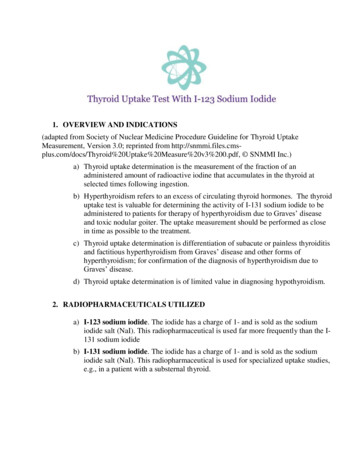
![Clinical significance of incidental [18 F]FDG uptake in the .](/img/32/s12876-016-0545-x.jpg)


